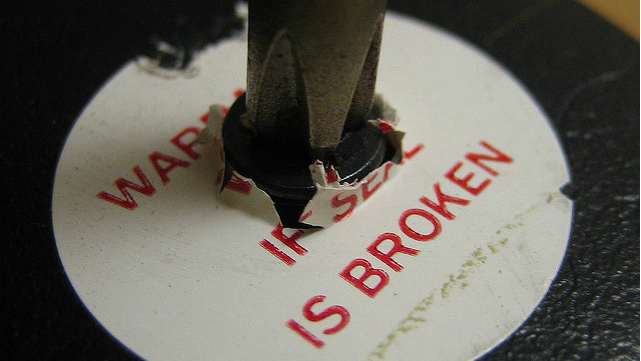
A manufacturer’s warranty is a guarantee that the product purchased is free of defect as a result of manufacturing for the given length of time as specified by the manufacturer, generally one year. Should you find that product to not function as it should, the manufacturer is obligated to repair or replace that product so it operates as intended. That seems pretty straight forward right, so why the “fine print”?
Time is the clearest way for a warranty to expire. While there are rare and special instances in which a manufacturer may grant some leeway in this case, if the period of warranty has expired, it becomes the responsibility of the owner to repair the product. Understandably, it can be frustrating when something fails after the warranty has expired; some people will tell you that they’ve experienced an issue with their product just days after the warranty expiration date. This usually occurs with products that have been used either extensively (wears out) or rarely (defective but didn’t use it enough to figure it out in time).
If you are still within your warranty period, you should note that physical damage that renders one or more of the functions useless, but is not caused by what is considered “normal use,†will cause the warranty to no longer be valid. What is considered “normal use†varies from one type of product to another. Unless it is otherwise specified, assume that intentional or accidental dropping, crushing, contorting, bending, forcing, and simply not using the product in the way it was intended, is considered mishandling. If you have to question whether your treatment of an item is normal, chances are it is not. Unless otherwise authorized and usually only within specific and strict parameters, modifications to the physical product or to the software can cancel out your warranty coverage as well; consult the manufacturer before you begin any alterations.
Even if you use your equipment in a normal manner, there are additional factors that are not covered by the manufacturer’s warranty and will result in a repair at the owner’s expense. These include water, sand, food, dirt, and other non-friendly substances. Removal or cleaning of these materials is not covered by most manufacturers’ warranties. Accidental damage caused while you, or an unauthorized person, attempt to clean any part of your equipment is not considered to be “normal use†and unfortunately won’t be met with much understanding by the manufacturer. An excess of heat or cold can cause the camera to stop working; the ability to function in these conditions is also not usually guaranteed by the manufacturer. In fact, excessive heat or sunlight can seriously damage equipment and is also commonly not covered; it should go without saying that fire damage is never covered under a manufacturer’s warranty.
Defective batteries that are designed to be replaceable by the end user are almost never covered by any manufacturer’s warranty. Typically, any damage that the battery creates (leaking, corroding, etc.) to your equipment is not included in the terms either. If you find yourself with a defective battery, it’s advisable to return to the store from which the product was purchased for an exchange; keep in mind the store’s return/exchange policy!
Manufacturers and repair facilities do not derive pleasure in denying warranty repairs. The operating, maintenance, and environmental instructions are usually outlined in the user manual of your equipment. As a consumer, we must understand that a product is warranted against manufacturer defect, not our accidental or intentional mistreatment of the product.
image by flickr user: andrew_cosand